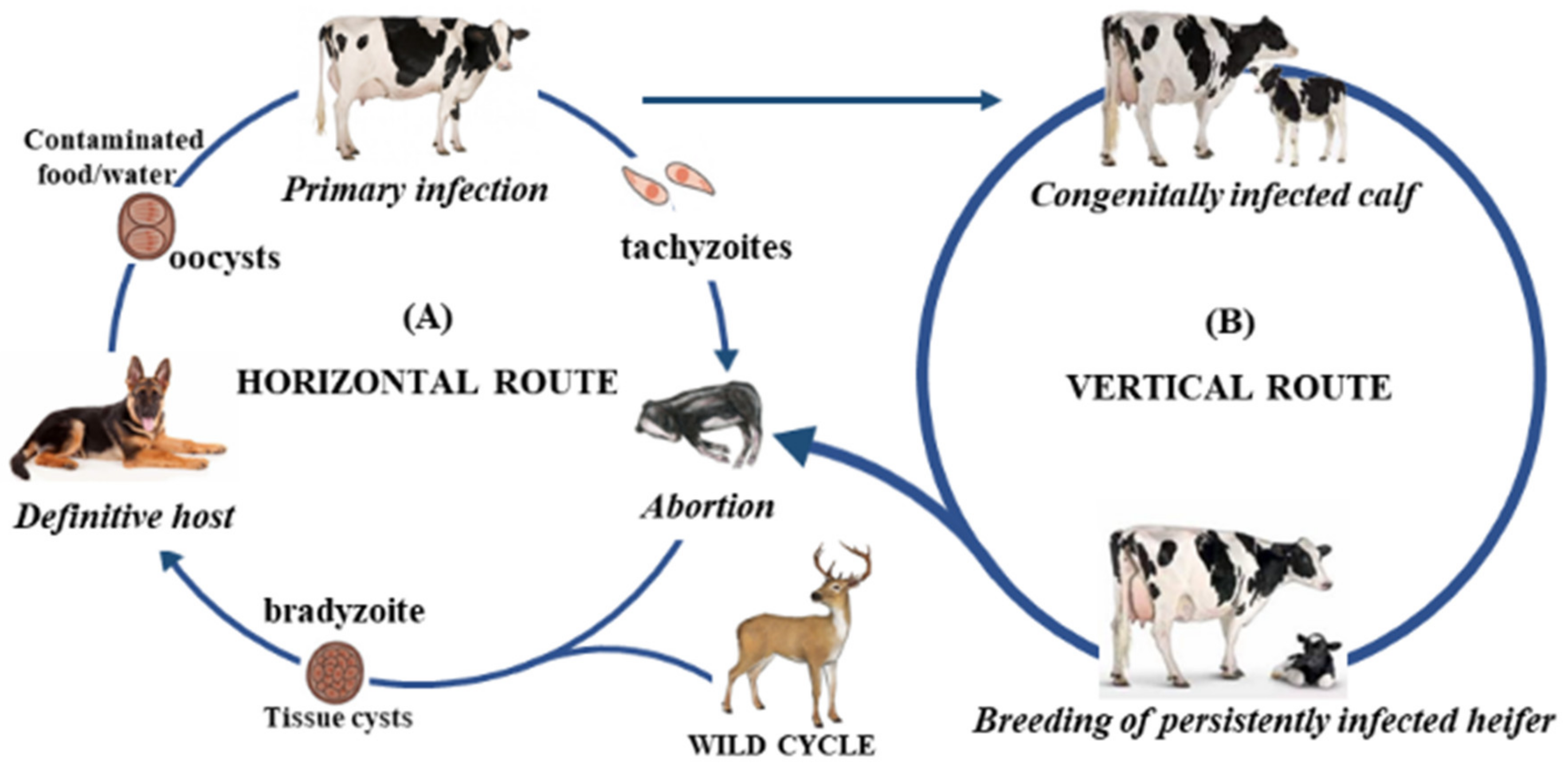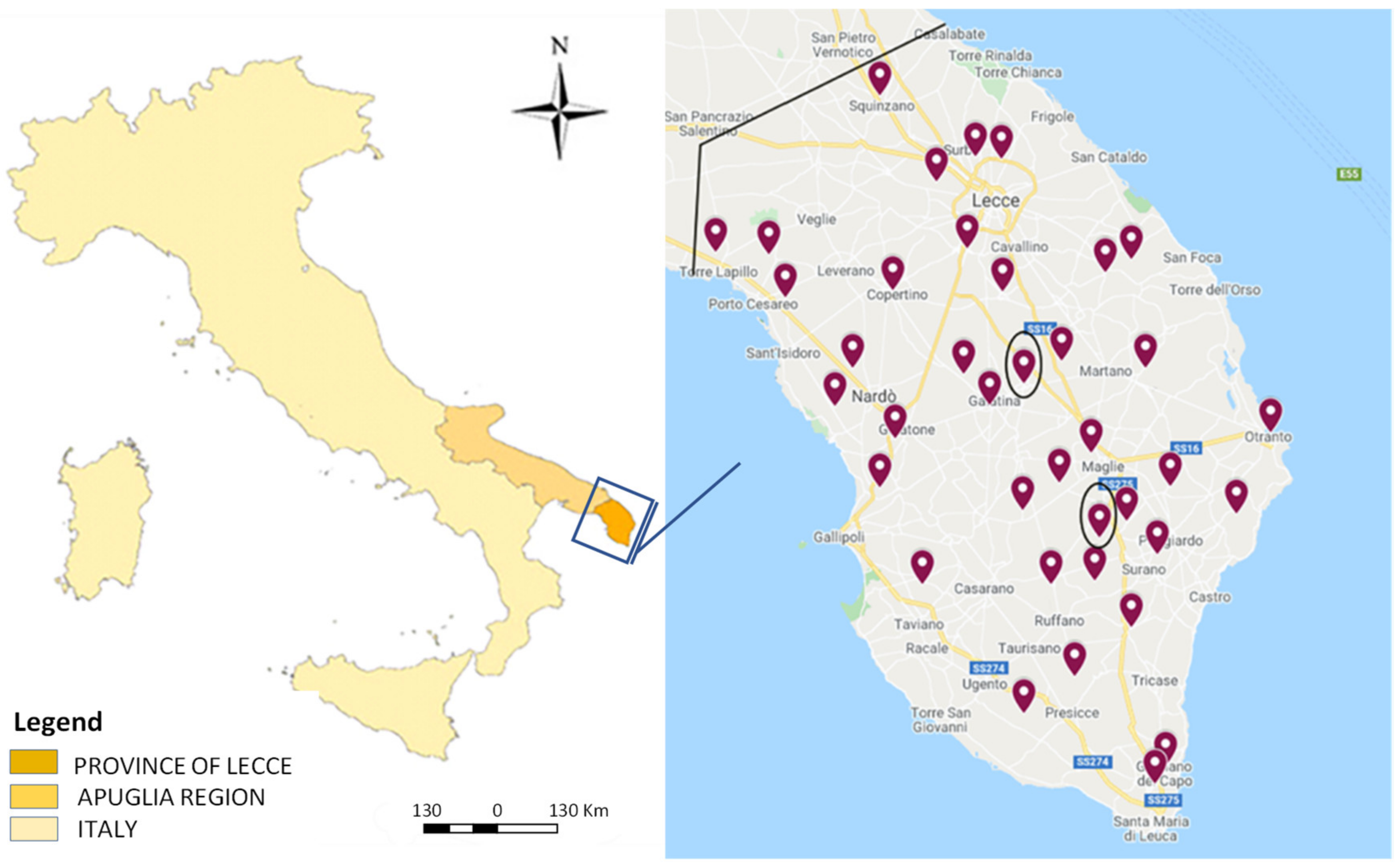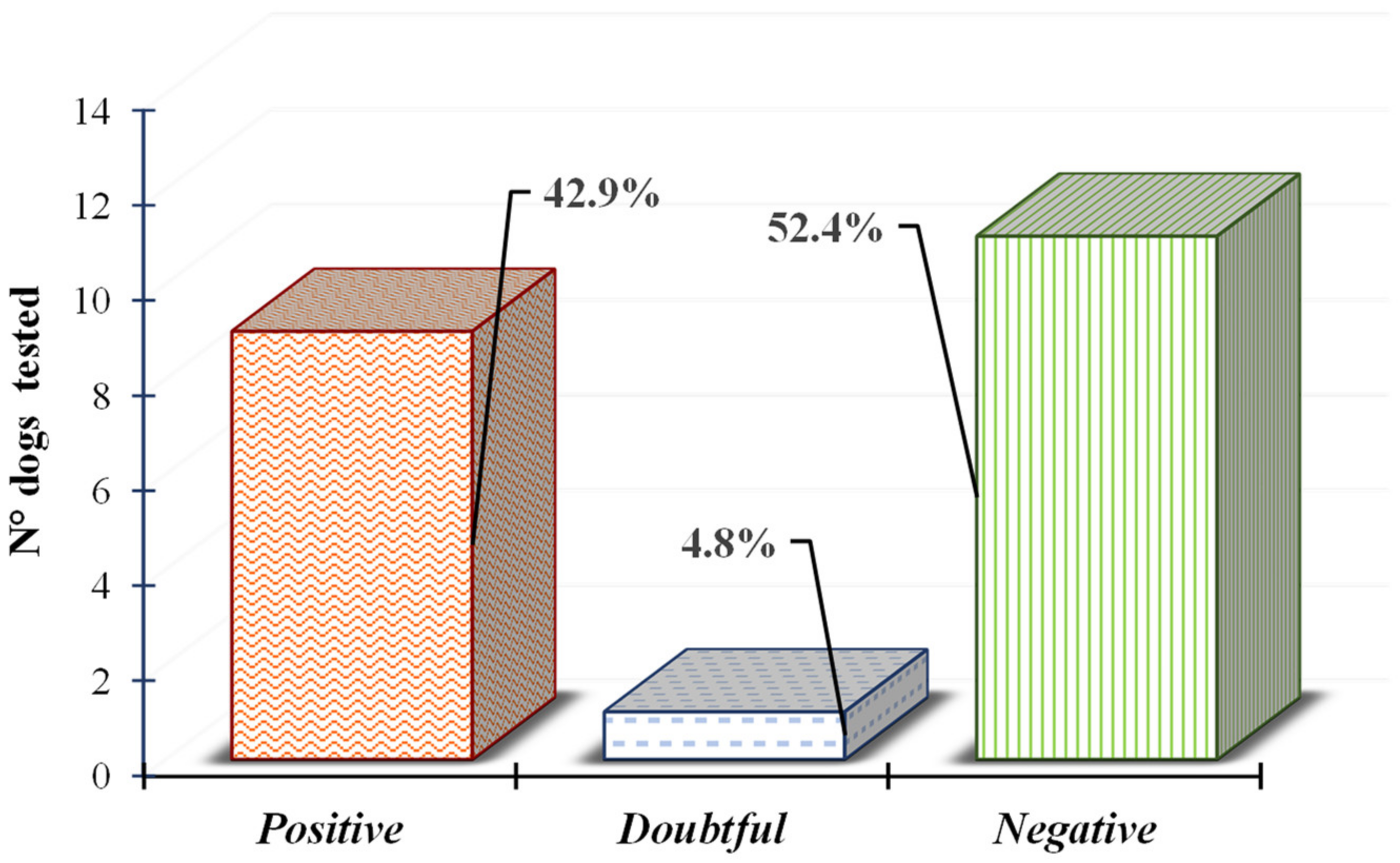Detection of Anti-Neospora caninum Antibodies on Dairy Cattle Farms in Southern Italy
Abstract
:1. Introduction
2. Materials and Methods
2.1. Institutional Animal Care and Use Committee
2.2. Sampling Procedures
2.3. Serological Testing and Procedures
2.4. Statistical Analysis
2.4.1. Data Set Point (a)
2.4.2. Data Set Point (b)
2.4.3. Data Set Point (c)
2.4.4. Data Set Point (d)
3. Results
3.1. Detection of Anti-Neospora caninum antibodies in Dairy Cattle
3.2. Statistical Analysis
3.3. Detection of Anti-Neospora caninum Antibodies in Farm Dogs
4. Discussion
5. Conclusions
Author Contributions
Funding
Institutional Review Board Statement
Informed Consent Statement
Data Availability Statement
Conflicts of Interest
References
- Goodswen, S.J.; Kennedy, P.J.; Ellis, J.T. A review of the infection, genetics, and evolution of Neospora caninum: From the past to the present. Infect. Genet. Evol. 2013, 13, 133–150. [Google Scholar] [CrossRef] [PubMed]
- Wilson, D.J.; Orsel, K.; Waddington, J.; Rajeev, M.; Sweeny, A.R.; Joseph, T.; Grigg, M.E.; Raverty, S.A. Neospora caninum is the leading cause of bovine fetal loss in British Columbia, Canada. Vet. Parasitol. 2016, 218, 46–51. [Google Scholar] [CrossRef] [PubMed] [Green Version]
- Liu, Y.; Reichel, M.P.; Lo, W.C. Combined control evaluation for Neospora caninum infection in dairy: Economic point of view coupled with population dynamics. Vet. Parasitol. 2020, 277, 108967. [Google Scholar] [CrossRef] [PubMed]
- Dubey, J.P. Review of Neospora caninum and neosporosis in animals. Korean J. Parasitol. 2003, 41, 1–16. [Google Scholar] [CrossRef] [Green Version]
- Dubey, J.P.; Lindsay, D.S. A review of Neospora caninum and neosporosis. Vet. Parasitol. 1996, 67, 1–59. [Google Scholar] [CrossRef]
- Reichel, M.P.; Ayanegui-Alcérreca, M.A.; Gondim, L.F.; Ellis, J.T. What is the global economic impact of Neospora caninum in cattle–the billion dollar question. Int. J. Parasitol. 2013, 43, 133–142. [Google Scholar] [CrossRef] [Green Version]
- Haddad, J.P.; Dohoo, I.R.; VanLeewen, J.A. A review of Neospora caninum in dairy and beef cattle—A Canadian perspective. Can. Vet. J. 2005, 46, 230–243. [Google Scholar]
- Dubey, J.P.; Hemphill, A.; Calero-Bernal, R.; Schares, G. Neosporosis in Animals; CRC Press: Boca Raton, FL, USA, 2017. [Google Scholar]
- Larson, R.L.; Hardin, D.K.; Pierce, V.L. Economic considerations for diagnostic and control options for Neospora caninum-induced abortions in endemically infected herds of beef cattle. J. Am. Vet. Med. Assoc. 2004, 224, 1597–1604. [Google Scholar] [CrossRef]
- Sager, H.; Fischer, I.; Furrer, K.; Strasser, M.; Waldvogel, A.; Boerlin, P.; Audigé, L.; Gottstein, B. A Swiss case–control study to assess Neospora caninum-associated bovine abortions by PCR, histopathology and serology. Vet. Parasitol. 2001, 102, 1–15. [Google Scholar] [CrossRef]
- Pereira-Bueno, J.; Quintanilla-Gozalo, A.; Pérez-Pérez, V.; Espi-Felgueroso, A.; Alvarez-Garcıa, G.; Collantes-Fernández, E.; Ortega-Mora, L.M. Evaluation by different diagnostic techniques of bovine abortion associated with Neospora caninum in Spain. Vet. Parasitol. 2003, 111, 143–152. [Google Scholar] [CrossRef] [Green Version]
- Otranto, D.; Lazari, A.; Testini, G.; Traversa, D.; di Regalbono, A.F.; Badan, M.; Capelli, G. Seroprevalence and associated risk factors of neosporosis in beef and dairy cattle in Italy. Vet. Parasitol. 2003, 118, 7–18. [Google Scholar] [CrossRef] [PubMed]
- Eleni, C.; Crotti, S.; Manuali, E.; Costarelli, S.; Filippini, G.; Moscati, L.; Magnino, S. Detection of Neospora caninum in an aborted goat foetus. Vet. Parasitol. 2004, 123, 271–274. [Google Scholar] [CrossRef] [PubMed]
- Magnino, S.; Vigo, P.G.; Fabbi, M.; Colombo, M.; Bandi, C.; Genchi, C. Isolation of a bovine Neospora from a newborn calf in Italy. Vet. Rec. 1999, 144, 456. [Google Scholar]
- Cabassi, C.S.; Taddei, S.; Galvani, G.; Cavirani, S. Neospora caninum. A Serological Survey on Antibody Prevalence in Dairy Cattle Herds with or without Dog. O&DV Obiettivi e Documenti Veterinari 2001, 22, 43–46. [Google Scholar]
- Gui, B.Z.; Lv, Q.Y.; Ge, M.; Li, R.C.; Zhu, X.Q.; Liu, G.H. First report of Neospora caninum infection in pigs in China. Transbound. Emerg. Dis. 2020, 67, 29–32. [Google Scholar] [CrossRef]
- De Barros, L.D.; Miura, A.C.; Minutti, A.F.; Vidotto, O.; Garcia, J.L. Neospora caninum in birds: A review. Parasitol. Int. 2018, 67, 397–402. [Google Scholar] [CrossRef] [PubMed]
- Ferroglio, E.; Pasino, M.; Ronco, F.; Bena, A.; Trisciuoglio, A. Seroprevalence of Antibodies to Neospora caninum in Urban and Rural Dogs in north-west Italy. Zoonoses Public Health 2007, 54, 135–139. [Google Scholar] [CrossRef] [PubMed]
- Robbe, D.; Passarelli, A.; Gloria, A.; Di Cesare, A.; Capelli, G.; Iorio, R.; Traversa, D. Neospora caninum seropositivity and reproductive risk factors in dogs. Exp. Parasitol. 2016, 164, 31–35. [Google Scholar] [CrossRef]
- Mazuz, M.L.; Leibovitz, B.; Savitsky, I.; Blinder, E.; Yasur-Landau, D.; Lavon, Y.; Sharir, B.; Tirosh-Levy, S. The Effect of Vaccination with Neospora caninum Live-Frozen Tachyzoites on Abortion Rates of Naturally Infected Pregnant Cows. Vaccines 2021, 9, 401. [Google Scholar] [CrossRef]
- Dijkstra, T.; Barkema, H.W.; Hesselink, J.W.; Wouda, W. Point source exposure of cattle to Neospora caninum consistent with periods of common housing and feeding and related to the introduction of a dog. Vet. Parasitol. 2002, 105, 89–98. [Google Scholar] [CrossRef]
- Gondim, L.F.; McAllister, M.M.; Pitt, W.C.; Zemlicka, D.E. Coyotes (Canis latrans) are definitive hosts of Neospora caninum. Int. J. Parasitol. 2004, 34, 159–161. [Google Scholar] [CrossRef] [Green Version]
- Dubey, J.P.; Jenkins, M.C.; Rajendran, C.; Miska, K.; Ferreira, L.R.; Martins, J.; Kwok, O.C.H.; Choudhary, S. Gray wolf (Canis lupus) is a natural definitive host for Neospora caninum. Vet. Parasitol. 2011, 181, 382–387. [Google Scholar] [CrossRef] [Green Version]
- Donahoe, S.L.; Lindsay, S.A.; Krockenberger, M.; Phalen, D.; Šlapeta, J.A. review of neosporosis and pathologic findings of Neospora caninum infection in wildlife. Int. J. Parasitol. Parasites Wildl. 2015, 4, 216–238. [Google Scholar] [CrossRef] [Green Version]
- King, J.S.; Šlapeta, J.; Jenkins, D.J.; Al-Qassab, S.E.; Ellis, J.T.; Windsor, P.A. Australian dingoes are definitive hosts of Neospora caninum. Int. J. Parasitol. 2010, 40, 945–950. [Google Scholar] [CrossRef]
- Dubey, J.P.; Lindsay, D.S. Neospora caninum induced abortion in sheep. J. Vet. Diagn. Investig. 1990, 2, 230–233. [Google Scholar] [CrossRef] [Green Version]
- Barber, J.S.; Trees, A.J. Clinical aspects of 27 cases of neosporosis in dogs. Vet. Rec. 1996, 139, 439–443. [Google Scholar] [CrossRef]
- McAllister, M.M.; Dubey, J.P.; Lindsay, D.S.; Jolley, W.R.; Wills, R.A.; McGuire, A.M. Rapid communication: Dogs are definitive hosts of Neospora caninum. Int. J. Parasitol. 1998, 28, 1473–1479. [Google Scholar] [CrossRef]
- Dubey, J.P.; Barr, B.C.; Barta, J.R.; Bjerkås, I.; Björkman, C.; Blagburn, B.L.; Bowman, D.D.; Buxton, D.; Ellis, J.T.; Gottstein, B.; et al. Redescription of Neospora caninum and its differentiation from related coccidia. Int. J. Parasitol. 2002, 32, 929–946. [Google Scholar] [CrossRef]
- Regidor-Cerrillo, J.; Arranz-Solís, D.; Benavides, J.; Gómez-Bautista, M.; Castro-Hermida, J.A.; Mezo, M.; Pérez, V.; Ortega-Mora, L.M.; González-Warleta, M. Neospora caninum infection during early pregnancy in cattle: How the isolate influences infection dynamics, clinical outcome and peripheral and local immune responses. Vet. Res. 2014, 45, 1–15. [Google Scholar] [CrossRef] [Green Version]
- Hall, C.A.; Reichel, M.P.; Ellis, J.T. Neospora abortions in dairy cattle: Diagnosis, mode of transmission and control. Vet. Parasitol. 2005, 128, 231–241. [Google Scholar] [CrossRef]
- Barr, B.C.; Conrad, P.A.; Breitmeyer, R.; Sverlow, K.; Anderson, M.L.; Reynolds, J.; Chauvet, A.E.; Dubey, J.P.; Ardans, A.A. Congenital Neospora infection in calves born from cows that had previously aborted Neospora-infected fetuses: Four cases (1990–1992). J. Am. Vet. Med. Assoc. 1993, 202, 113–117. [Google Scholar]
- Davison, H.C.; Otter, A.; Trees, A.J. Estimation of vertical and horizontal transmission parameters of Neospora caninum infections in dairy cattle. Int. J. Parasitol. 1999, 29, 1683–1689. [Google Scholar] [CrossRef]
- Barry, R.; Nissly, R.H.; Feria, W.; Thirumalapura, N.; Tewari, D.; Jayarao, B.M.; Kuchipudi, S.V. A probe-based real-time PCR assay for the detection of Neospora caninum in clinical samples from cattle. Vet. Parasitol. 2019, 269, 2–6. [Google Scholar] [CrossRef] [PubMed]
- Schares, G.; Langenmayer, M.C.; Majzoub-Altweck, M.; Scharr, J.C.; Gentile, A.; Maksimov, A.; Schares, S.; Conraths, F.J.; Gollnick, N.S. Naturally acquired bovine besnoitiosis: Differential distribution of parasites in the skin of chronically infected cattle. Vet. Parasitol. 2016, 216, 101–107. [Google Scholar] [CrossRef] [PubMed]
- Lucchese, L.; Benkirane, A.; Hakimi, I.; El Idrissi, A.; Natale, A. Seroprevalence study of the main causes of abortion in dairy cattle in Morocco. Vet. Ital. 2016, 52, 3–19. [Google Scholar]
- Tramuta, C.; Lacerenza, D.; Zoppi, S.; Goria, M.; Dondo, A.; Ferroglio, E.; Nebbia, P.; Rosati, S. Development of a set of multiplex standard polymerase chain reaction assays for the identification of infectious agents from aborted bovine clinical samples. J. Vet. Diagn. 2011, 23, 657–664. [Google Scholar] [CrossRef]
- Al-Qassab, S.; Reichel, M.P.; Ellis, J. A second generation multiplex PCR for typing strains of Neospora caninum using six DNA targets. Mol. Cell. Probes 2010, 24, 20–26. [Google Scholar] [CrossRef]
- Lindsay, D.S.; Dubey, J.P. Immunohistochemical diagnosis of Neospora caninum in tissue sections. Am. J. Vet. Res. 1989, 50, 1981–1983. [Google Scholar]
- Dubey, J.P.; Schares, G. Diagnosis of bovine neosporosis. Vet. Parasitol. 2006, 140, 1–34. [Google Scholar] [CrossRef]
- De Meerschman, F.; Focant, C.; Detry, J.; Rettigner, C.; Cassart, D.; Losson, B. Clinical pathological and diagnostic aspects of congenital neosporosis in a series of naturally infected calves. Vet. Rec. 2005, 157, 115–118. [Google Scholar] [CrossRef]
- Abdelbaky, H.H.; Nishimura, M.; Shimoda, N.; Hiasa, J.; Fereig, R.M.; Tokimitsu, H.; Inokuma, H.; Nishikawa, Y. Evaluation of Neospora caninum serodiagnostic antigens for bovine neosporosis. Parasitol. Int. 2020, 75, 102045. [Google Scholar] [CrossRef]
- Guido, S.; Katzer, F.; Nanjiani, I.; Milne, E.; Innes, A. Serology-based diagnostics for the control of bovine neosporosis. Trends Parasitol. 2016, 32, 131–143. [Google Scholar] [CrossRef] [Green Version]
- Sinnott, F.A.; Monte, L.G.; Collares, T.F.; Silveira, R.M.; Borsuk, S. Review on the immunological and molecular diagnosis of neosporosis (years 2011–2016). Vet. Parasitol. 2017, 239, 19–25. [Google Scholar] [CrossRef]
- Villa, L.; Maksimov, P.; Luttermann, C.; Tuschy, M.; Gazzonis, A.L.; Zanzani, S.A.; Mortarino, M.; Conraths, F.J.; Manfredi, M.T.; Schares, G. Spatial distance between sites of sampling associated with genetic variation among Neospora caninum in aborted bovine foetuses from northern Italy. Parasites Vectors 2021, 14, 1–14. [Google Scholar] [CrossRef]
- Paradies, P.; Capelli, G.; Testini, G.; Cantacessi, C.; Trees, A.J.; Otranto, D. Risk factors for canine neosporosis in farm and kennel dogs in southern Italy. Vet. Parasitol. 2007, 145, 240–244. [Google Scholar] [CrossRef]
- Licitra, F.; Perillo, L.; Antoci, F.; Piccione, G.; Giannetto, C.; Salonia, R.; Giudice, E.; Monteverde, V.; Cascone, G. Management Factors Influence Animal Welfare and the Correlation to Infectious Diseases in Dairy Cows. Animals 2021, 11, 3321. [Google Scholar] [CrossRef]
- Sala, G.; Gazzonis, A.; Boccardo, A.; Coppoletta, E.; Galasso, C.; Manfredi, M.T.; Pravettoni, D. Using beef-breed semen in seropositive dams for the control of bovine neosporosis. Prev. Vet. Med. 2018, 161, 127–133. [Google Scholar] [CrossRef]
- Rinaldi, L.; Pacelli, F.; Iovane, G.; Pagnini, U.; Veneziano, V.; Fusco, G.; Cringoli, G. Survey of Neospora caninum and bovine herpes virus 1 coinfection in cattle. Parasitol. Res. 2007, 100, 359–364. [Google Scholar] [CrossRef]
- Alvarez-García, G.; García-Culebras, A.; Gutiérrez-Expósito, D.; Navarro-Lozano, V.; Pastor-Fernández, I.; Ortega-Mora, L.M. Serological diagnosis of bovine neosporosis: A comparative study of commercially available ELISA tests. Vet. Parasitol. 2013, 198, 85–95. [Google Scholar] [CrossRef]
- Regidor-Cerrillo, J.; Horcajo, P.; Ceglie, L.; Schiavon, E.; Ortega-Mora, L.M.; Natale, A. Genetic characterization of Neospora caninum from Northern Italian cattle reveals high diversity in European N. caninum populations. Parasitol. Res. 2020, 119, 1353–1362. [Google Scholar] [CrossRef]
- Varcasia, A.; Capelli, G.; Ruiu, A.; Ladu, M.; Scala, A.; Bjorkman, C. Prevalence of Neospora caninum infection in Sardinian dairy farms (Italy) detected by iscom ELISA on tank bulk milk. Parasitol. Res. 2006, 98, 264–267. [Google Scholar] [CrossRef]
- Machacova, T.; Bártová, E.; Sedlák, K.; Slezáková, R.; Budíková, M.; Piantedosi, D.; Veneziano, V. Seroprevalence and risk factors of infections with Neospora caninum and Toxoplasma gondii in hunting dogs from Campania region, southern Italy. Folia Parasitol. 2016, 63, 12. [Google Scholar] [CrossRef] [PubMed] [Green Version]
- Dubey, J.P.; Schares, G.; Ortega-Mora, L.M. Epidemiology and control of neosporosis and Neospora caninum. Clin. Microbiol. Rev. 2007, 20, 323–367. [Google Scholar] [CrossRef] [PubMed] [Green Version]
- Reichel, M.P.; Wahl, L.C.; Ellis, J.T. Research into Neospora caninum-what have we learnt in the last thirty years? Pathogens 2020, 9, 505. [Google Scholar] [CrossRef] [PubMed]
- Serrano-Martínez, M.E.; Cisterna, C.A.B.; Romero, R.C.E.; Huacho, M.A.Q.; Bermabé, A.M.; Albornoz, L.A.L. Evaluation of abortions spontaneously induced by Neospora caninum and risk factors in dairy cattle from Lima, Peru. Rev. Bras. Parasitol. Vet. 2019, 28, 215–220. [Google Scholar] [CrossRef]
- Gharekhani, J.; Yakhchali, M. Neospora caninum infection in dairy farms with history of abortion in West of Iran. Vet. Anim. Sci. 2019, 8, 100071. [Google Scholar] [CrossRef]
- Melendez, P.; Ilha, M.; Woldemeskel, M.; Graham, J.; Coarsey, M.; Baughman, D.; Whittington, L.; Naikare, H. An outbreak of Neospora caninum abortion in a dairy herd from the State of Georgia, United States. Vet. Med. Sci. 2021, 7, 141–147. [Google Scholar] [CrossRef]
- Barberio, A.; Natale, A. Neosporosi bovina. LINEE GUIDA in VET 5, 1st ed.; Istituto Zooprofilattico Sperimentale delle Venezie: Legnaro, Italy, 2017. [Google Scholar]
- Nardelli, S.; Ceglie, L.; Merenda, M.; Dellamaria, D.; Natale, A.; Frangipane di Regalbono, A.; Capelli, G. Monitoring dairy cattle neosporosis in Veneto region, northeastern Italy. In Proceedings of the 20th International Conference WAAP, Christchurch, New Zealand, 16–20 October 2005. [Google Scholar]
- Tamponi, C.; Varcasia, A.; Pipia, A.P.; Zidda, A.; Panzalis, R.; Dore, F.; Dessì, G.; Sanna, G.; Salis, F.; Björkman, C.; et al. ISCOM ELISA in milk as screening for Neospora caninum in dairy sheep. Large Anim. Rev. 2015, 21, 213–216. [Google Scholar]
- Cascone, G.; Vesco, G.; D’Orazi, A.; Curro, V.; Reale, S.; Caracappa, S. Seroprevalence of Neospora caninum in Dairy Cattle. Preliminary Study (Sicily); Atti della Societa’Italiana di Buiatria: Parma, Italy, 2002. [Google Scholar]
- Magnino, S.; Vigo, P.G.; Bandi, C.; Rosignoli, C.; Boldini, M.; Vezzoli, F.; Alborali, L.; Cammi, G.; Foni, E.; Colombo, N.; et al. Neosporosi bovina in Italia: Un biennio di attività diagnostica. Sel. Vet. 2000, S15–S23. [Google Scholar]
- Fávero, J.F.; Da Silva, A.S.; Campigotto, G.; Machado, G.; de Barros, L.D.; Garcia, J.L.; Vogel, F.F.; Mendes, R.E.; Stefani, L.M. Risk factors for Neospora caninum infection in dairy cattle and their possible cause-effect relation for disease. Microb. Pathog. 2017, 110, 202–207. [Google Scholar] [CrossRef]
- Wouda, W.; Dijkstra, T.; Kramer, A.M.H.; Van Maanen, C.; Brinkhof, J.M.A. Seroepidemiological evidence for a relationship between Neospora caninum infections in dogs and cattle. Int. J. Parasitol. 1999, 29, 1677–1682. [Google Scholar] [CrossRef]
- Moore, D.P. Neosporosis in South America. Vet. Parasitol. 2005, 127, 87–97. [Google Scholar] [CrossRef]
- Wouda, W.; Moen, A.R.; Schukken, Y.H. Abortion risk in progeny of cows after a Neospora caninum epidemic. Theriogenology 1998, 49, 1311–1316. [Google Scholar] [CrossRef]
- Paré, J.; Fecteau, G.; Fortin, M.; Marsolais, G. Seroepidemiologic study of Neospora caninum in dairy herds. J. Am. Vet. Med. Assoc. 1998, 213, 1595–1598. [Google Scholar]
- Thurmond, M.; Hietala, S. Strategies to control Neospora infection in cattle. Bovine Pract. 1995, 29, 60–63. [Google Scholar]
- Anderson, M.L.; Reynolds, J.P.; Rowe, J.D.; Sverlow, K.W.; Packham, A.E.; Barr, B.C.; Conrad, P.A. Evidence of vertical transmission of Neospora sp. infection in dairy cattle. J. Am. Vet. Med. Assoc. 1997, 210, 1169–1172. [Google Scholar]
- Ould-Amrouche, A.; Klein, F.; Osdoit, C.; Mohammed, H.O.; Touratier, A.; Sanaa, M.; Mialot, J.P. Estimation of Neospora caninum seroprevalence in dairy cattle from Normandy, France. Vet. Res. 1999, 30, 531–538. [Google Scholar]
- Bartels, C.J.M.; Wouda, W.; Schukken, Y.H. Risk factors for Neospora caninum-associated abortion storms in dairy herds in The Netherlands (1995 to 1997). Theriogenology 1999, 52, 247–257. [Google Scholar] [CrossRef]
- Schares, G.; Bärwald, A.; Staubach, C.; Ziller, M.; Klöss, D.; Wurm, R.; Rauser, M.; Labohm, R.; Dräger, K.; Fasen, W.; et al. Regional distribution of bovine Neospora caninum infection in the German state of Rhineland-Palatinate modelled by Logistic regression. Int. J. Parasitol. 2003, 33, 1631–1640. [Google Scholar] [CrossRef]
- Mainar-Jaime, R.; Thurmond, M.; Berzal-Herranz, B.; Hietala, S. Seroprevalence of Neospora caninum and abortion in dairy cows in northern Spain. Vet. Rec. 1999, 145, 72–75. [Google Scholar] [CrossRef]



| FARMS | TOT | <2 years | >2 years | Positive | Doubtful | Negative |
|---|---|---|---|---|---|---|
| no-RDF * | 706 | 262 (37.1%) | 444 (62.9%) | 149 (21.1%) | 6 (0.8%) | 551 (78.1%) |
| RDF ** | 60 | 39 (65.0%) | 21 (35.0%) | 38 (63.3%) | 1 (1.7%) | 21 (35.0%) |
| Dairy Cattle Samples | Positive to ELISA | Negative to ELISA |
|---|---|---|
| <2 years (A) | 44 (a) | 216 |
| >2 years (B) | 105 (b) | 335 |
| Farms | Positive to ELISA Test | Negative to ELISA Test |
|---|---|---|
| RDF (C) | 38 (c) | 21 |
| no-RDF (D) | 149 (d) | 551 |
| Farms | Positive to ELISA Test | Negative to ELISA Test |
|---|---|---|
| RDF (E) | 25 (e) | 13 |
| no-RDF (F) | 44 (f) | 216 |
| Dairy cattle samples | Positive to ELISA Test | Negative to ELISA Test |
|---|---|---|
| <2 years (G) | 25 (g) | 13 |
| >2 years (H) | 13 (h) | 8 |
Publisher’s Note: MDPI stays neutral with regard to jurisdictional claims in published maps and institutional affiliations. |
© 2022 by the authors. Licensee MDPI, Basel, Switzerland. This article is an open access article distributed under the terms and conditions of the Creative Commons Attribution (CC BY) license (https://creativecommons.org/licenses/by/4.0/).
Share and Cite
Manca, R.; Ciccarese, G.; Scaltrito, D.; Chirizzi, D. Detection of Anti-Neospora caninum Antibodies on Dairy Cattle Farms in Southern Italy. Vet. Sci. 2022, 9, 87. https://doi.org/10.3390/vetsci9020087
Manca R, Ciccarese G, Scaltrito D, Chirizzi D. Detection of Anti-Neospora caninum Antibodies on Dairy Cattle Farms in Southern Italy. Veterinary Sciences. 2022; 9(2):87. https://doi.org/10.3390/vetsci9020087
Chicago/Turabian StyleManca, Raffaella, Giuseppina Ciccarese, Domenico Scaltrito, and Daniela Chirizzi. 2022. "Detection of Anti-Neospora caninum Antibodies on Dairy Cattle Farms in Southern Italy" Veterinary Sciences 9, no. 2: 87. https://doi.org/10.3390/vetsci9020087
APA StyleManca, R., Ciccarese, G., Scaltrito, D., & Chirizzi, D. (2022). Detection of Anti-Neospora caninum Antibodies on Dairy Cattle Farms in Southern Italy. Veterinary Sciences, 9(2), 87. https://doi.org/10.3390/vetsci9020087







